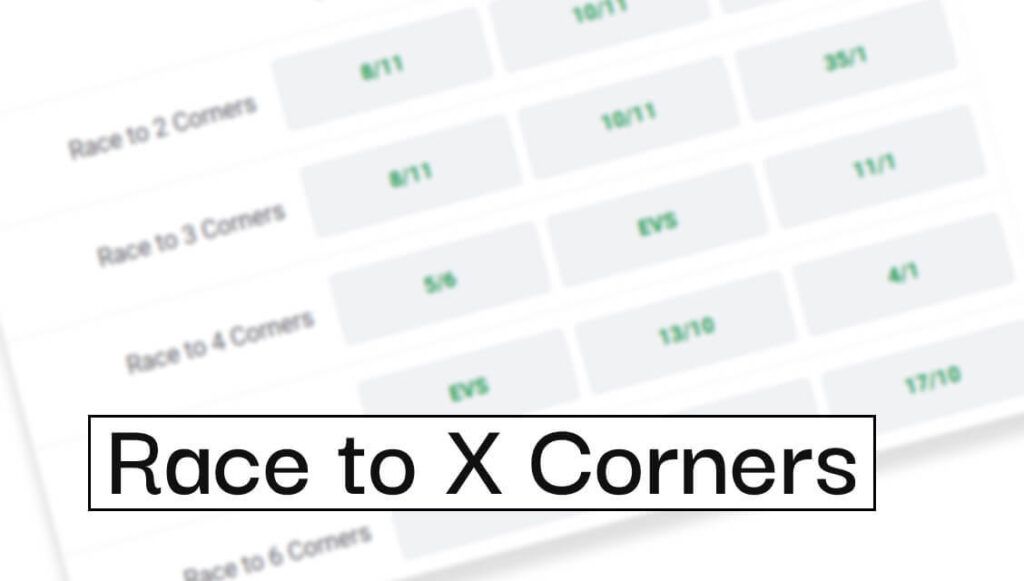
Ultimate Guide to Betting on Corners in Football

Andy Robson
Andy Robson is the most popular betting tipster in the UK. With a combined following in excess of 1 million people across his social media channels, Andy has built a loyal audience by consistently providing quality betting content for over nine years. He is the founder of Andy’s Bet Club, which he launched in 2019.
For the uninitiated and ill-informed, corners betting in football is simply a guessing game, a fun bet, or a way to create a bigger price on bet builders.
There are gamblers out there who bet for fun and can, hopefully, afford to take on those losses, and therefore having a fun corner bet works. Corner bets, especially the over lines, is something that bettors can cheer on all match to gain a vested interest in a match from start to finish, potentially adding more excitement to the occasion,
However, this guide is here for profit-making. There are a number of aspects to take into consideration when weighing up the corners market, and with a combination of these it is possible for long term profits to be made.
Initially, however, it is best for us to define the market that we are discussing, and how the mechanics of the corner betting market works.
Andy’s Bet Club is a hub for quality betting resources and tools to help our community make smarter betting decisions.
For example, our Opta-powered bet builder stats tool provides insights and data via football cheat sheets, drawing team and player prop data for each match such as fouls won betting, shots on target betting and many more.
This research allows for crucial justification for bets like our Premier League accumulator tips, EFL accumulator tips and European accumulator tips. This will be an invaluable tool as we look towards our Euro 2024 predictions.
The data used in this article was accurate at the time of writing.
What is corners betting?
A whole variety of markets have been built around corners. In essence, it is a very simple, easy-to-understand concept, when football matches are underway both teams can win corners, and basically, one is betting on the number of corners that a team may win in a period of time.
You can use Andy's Bet Club to gain valuable insight into corners data for each match via our Bet Builder stats tool. For each game you can study match stats called cheat sheets where they provide corners stats.

Under/Over Corners
The most popular and well known corners market is the straightforward over/under line. This is a case of the market explaining exactly what it represents, i.e. if the betting line is set at 9.5, you can bet under or over that line. If you bet over 9.5 then if your team, or the match, sees ten or more corners then you win.

Some bookmakers will only offer overs on the corner markets. Be aware that sometimes this means that they will use prices on that market that are skewed towards the overs, knowing that they do not have to lay the other side of the market.
Also in this market, some bookmakers will allow you to bet on an exact number of corners, obviously, this is a very difficult market, but, at the same time, the rewards are much greater.
Total Corners (Groups)
If you think that you have a good handle on approximately how many corners there will be in a match, it may well be worth checking the odds of the grouped totals.
This market allows you to be correct within a range, i.e. 9-11, 12-14, Over 14, and if you land in the correct range you are a winner. This allows bettors the opportunity to perhaps get better odds for their predictions, as, especially pre-match, the odds for each group will be odds against.
Race to X Corners
Again, does what it says on the tin. Back a team to be the first one to reach a certain number of corners.
One thing to bear in mind when betting in this market, however, is that the contest isn't only between the two teams, but also against the clock. It is often the case that a gambler will fancy a team to beat the other team to get to a certain corner count only to be beaten by the final whistle.

This often becomes an interesting market in-play, especially when weather conditions or the scoreline plays a part.
First/Last Corners
Betting on the team to take the first or last corner of a match may seem like a lucky dip, but if you know that a particular team has a reputation for a fast start or you fancy that a team will come on strong in the latter stages it could be a worthwhile bet.
First Half/Second Half/First 10/Last 10 Corners
Temporal markets such as these can be useful to use if certain trends are spotted in the research or data.
Often the odds for these lines are simply straight calculations based on the initial line that the bookmakers have calculated for the game, this can leave them open to strong trends that haven’t been taken into consideration.
Asian Corners
Another variation of the under/over corner betting is the Asian corner market. These markets are presented in whole number terms, i.e. ten corners or more. This allows you to receive a whole stake back if the match finishes on exactly ten corners and a full payout on 11 or more.
This is a popular option for many professional gamblers.
Corner Match Betting
This is where the bookmaker will pitch the teams against each other to work out who might win the most corners in the match. This market is often underpinned by the match probability market as well as the averages of each club home and away.
We often see the favourites for the match also the favourites in this market, but research can often find an edge in this market if one of the teams’ tactics often result in corners, despite the fact that they may not be as strong a team overall.
Be very aware in this market that the draw is a key runner. Even though there are likely to be many more corners than goals, there is also a reasonable chance that the teams could finish on the same number of corners. This is usually very profitable for the bookmaker as the vast majority of the bets will be stuck on one team or the other.
Advantages of betting on the corners market
There are certain advantages to betting on a market such as the corners market. When betting on goals or the match market, there is a great deal of chance and reliance on finishing prowess.
Football is a low-scoring game in which outcomes can be decided on a single incident of luck or decision-making. Corners are partially down to luck, but because there are many more of them in game, it becomes a different measure of the game.
There is a lot of research that can be done on corners that is likely to be relevant in a match as well. There are repeated patterns within corners winning, whether they be tactical or connected to team strength, home and away form or something else. All of this work can be done before the match as a system can be created to produce consistent profits.
Corners betting as singles/multiples
As with all betting, a sustainable edge needs to be found to create profits.
Often betting on singles means that the amount of money staked to create worthwhile returns needs to be greater, but it is the most reliable way to sustain a profit.
However, if one is confident that their system is creating an edge over the bookmaker’s margins, then multiplying that edge by creating multiples that beat the system can really add to the profits.
Corners betting as part of a bet builder
There is no harm in adding a corners bet into a bet builder selection, as long as the rules of the system or the confidence in the edge dictates that the bet is a value selection.

The experts on Andy's Bet Club cover Premier League bet builder tips, European football betting predictions and EFL predictions and much more. The games we cover either via a betting preview or bet builder punts can be found on our football betting tips.
Statistical Analysis
As has been discussed in the previous section, research is absolutely vital in making corner betting success a long term reality.
Bookmakers certainly do their research. They have models that are programmed to use the data that is out there on certain leagues and certain clubs to calculate a line for expected corners. The prices for all markets connected to corners are then derived from this figure.
There are positives and negatives to this approach from a gambler’s point of view.
It should mean that there are fewer tremendous errors from the bookmaker and it should mean that in leagues where data is plentiful and well-watched, prices should be accurately positioned.
However, there are methods that can be used to combat this system.
Firstly, on some occasions, the bookmaker will use a league average or a historical average to calculate the key number lines. Therefore, if a bettor finds a club or a couple of clubs who are outliers when it comes to their corners data, either conceding or winning lots of corners, or had a particular discernable pattern that was identifiable i.e. winning lots of injury time corners, then there is likely to be some value in the pre-match lines.
Also, if one is willing to bet in more obscure markets, one has more potential to find value. However, bear in mind that bookmakers do also up their margins in obscure markets and obscure leagues that they themselves are more unsure about.
Overall, the absolute key to success in beating the bookmaker in corner betting is doing the research.
Average corners per game/per league/per team
To give you a helping hand in the research we have provided a table containing some valuable information on some leagues across the world and the average number of corners per league. Numbers accurate at the time of writing.
Remember though that this average number is often how the bookmakers can derive their corner lines for the fixtures in that league. To find an edge we might need to go into a greater depth of research.
There are some useful resources out there on the internet for you to use to conduct the level of research necessary to achieve that edge.
One of the best free resources for corner betting comes from the website https://www.thestatsdontlie.com/ who provide detailed statistics from all over the world on corners, and many other data points.
Soccer Stats also provide corner data for many major leagues, and one of the benefits of their data is that they break corners down into 8.5+, 9.5+ and 10.5+ lines as well as home and away data.

Average corners first half/Average corners second half
The general rule of thumb is that there are slightly more corners in the second halves of matches. There are a few perceived reasons for this, but one of the main ones is simply the amount of time in the second half. Although, ostensibly, football is a game of two halves, there is usually more stoppage time added at the end of the second half, usually due to substitutions.
There is also the theory that tiredness makes a difference, with the added likelihood of one or both teams really going for the win towards the end of the game, or, perhaps, trying to come back from a deficit.
An example of the difference between first and second half corner totals comes from the Austrian Bundesliga. At the time of writing, there have been 557 corners in the first half, but 629 in the second half, a 13% increase in the second half. However, this is not to say that it is a hard and fast rule, many teams and matches see more first half corners than second half.
We discussed earlier about the potential of taking advantage of the time-limited markets, and using the data from the Austrian Bundesliga there is a really good example of how research can work in your favour in these markets.
Just below we can see the average corner wins for the Austrian Bundesliga in the first half of matches so far in the 2023/24 season at the time of writing. SK Rapid top the charts for corner wins at home in the first half with 3.67 corners per first half.
However, looking at the second half data below, we see that SK Rapid actually win fewer corners in the second half when playing at home, only 2.83 on average, almost a whole corner less. Salzburg actually follow the same trend as well, 2.92 corners in the first half at home, and only 2 in the second half.
The patterns don’t follow away from home though, which leads us to the next section.
Just before we leave the 1st half/2nd half advice, it is worth mentioning an in-play tactic that has some merit. When a match is a draw at half-time, it is often worth betting the 2nd half overs on the premise that one or both teams will be going for the win and attacking play will lead to more corners.
Average corners home / Average corners away
Some teams play very differently away from home than they do at home. The example below is from the EFL Championship.
There are only two teams in the league who have averaged more corners away from home than at home, Sheffield Wednesday and Sunderland. This could be useful information if they are continually priced up on lower lines away from home.
A team such as Watford win almost twice as many home corners as they do away, and Leeds United are notable for how few corners they concede at home, far fewer than anyone else in the league.
Tactics
There are plenty of factors that influence the number of corners for one team or another.
Team strength is definitely one of those things. It is common sense that if one team is much stronger than the other they will tend to have a great territorial advantage, probably more shots and penetrative passes, and, therefore, more corners.
Obviously, this is reflected in the prices. The corner match betting market is the indicator of how much dominance a team is expected to have over their opponents.
However, there are occasions in which it is the tactical approach of the teams in the match which can sometimes if identified, give a bettor an advantage in the market.
What tactics influence more or less corners
It has been mentioned on a couple of occasions in passing that attacking play tends to result in more corners. This is a logical argument based on the fact that territory in the final third is the main way that corners are won, either by shooting and gaining a deflection via a defender or goalkeeper, or by crossing and having a defending player block or header it behind for a corner.
It is important, however, that one doesn’t mistake territory solely as attacking play. Cycling the ball from one side of the field to the other inside an opponent’s half, looking to pass a way through doesn’t encourage more corners. Indeed, patient positional play of that ilk often reduces the number of corners in a game as the time ticks on as possession is being kept at a distance from the dead ball line.
Something to look for in a team setup if one is interested in the number of corners to be expected in a match, is what kind of forwards are playing wide in the team. If a team has set up with players on their opposite wings, i.e. a left footed player on the right, then this doesn’t necessarily encourage a player to get to the dead ball line for a crossing opportunity, which is a key way of corners being won.
However, if a team is playing two “classic” wingers who have high carry/dribble numbers and are known to want to get past their man and whip a cross in, then this is a recipe for corners, and one which is unlikely to have been taken into account when the bookmakers have priced the lines for the match.
Tactics and team performance are definitely something to watch out for from an in-play perspective if one has the opportunity to watch a match while betting on it. While the scoreline and domination of the game will be taken into account by the model the bookmakers use, it is not nuanced to the type of gameplan that the teams are using.








